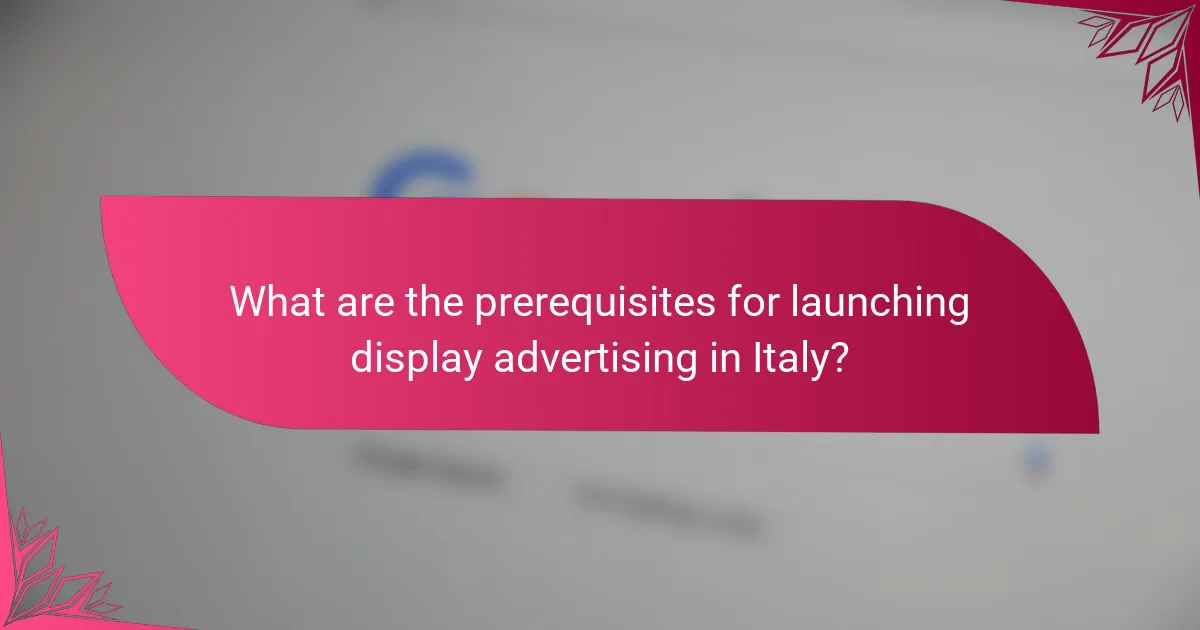Effective display advertising strategies in Italy require a deep understanding of local audiences and cultural nuances. By tailoring campaigns to resonate with Italian consumers, businesses can significantly enhance engagement and conversion rates. Focusing on cultural relevance and visual appeal is essential for optimizing ad performance in this unique market.

What are effective display advertising strategies for Italy?
Effective display advertising strategies for Italy focus on understanding local audiences, leveraging cultural nuances, and optimizing placements. By tailoring campaigns to resonate with Italian consumers, businesses can enhance engagement and conversion rates.
Targeting local demographics
Targeting local demographics involves understanding the specific characteristics of Italian consumers, such as age, gender, income level, and regional preferences. Utilize data analytics tools to gather insights on your target audience, ensuring your ads are relevant to their interests and behaviors.
Consider segmenting your audience based on regional differences, as preferences can vary significantly between northern and southern Italy. For instance, urban areas like Milan may respond differently to ads compared to rural regions.
Utilizing Italian cultural themes
Incorporating Italian cultural themes into your display advertising can create a stronger connection with your audience. Use imagery, colors, and symbols that resonate with Italian heritage, such as references to local cuisine, art, or fashion.
For example, a campaign promoting a food product might feature traditional Italian dishes or local ingredients, appealing to the pride Italians have in their culinary culture. This approach can enhance brand relatability and trust.
Leveraging regional events
Regional events, such as festivals, holidays, or sports events, provide excellent opportunities for targeted advertising. Align your campaigns with these occasions to capture the attention of potential customers when they are most engaged.
For instance, promoting travel packages during the Venice Carnival or special offers during the summer holiday season can significantly boost visibility and relevance. Ensure your messaging reflects the spirit of the event to maximize impact.
Optimizing ad placements on Italian websites
Choosing the right websites for ad placements is crucial for reaching your target audience effectively. Focus on popular Italian websites that align with your brand values and target demographics, such as news portals, lifestyle blogs, or e-commerce platforms.
Utilize programmatic advertising to automate the placement process, allowing for real-time adjustments based on performance metrics. This ensures your ads are displayed where they are most likely to generate clicks and conversions.
Implementing retargeting campaigns
Retargeting campaigns are essential for re-engaging users who have previously interacted with your brand. By displaying ads to these users across various platforms, you can remind them of your products or services and encourage them to return.
Set up retargeting pixels on your website to track visitor behavior and create tailored ads that address their specific interests. This strategy can significantly increase conversion rates, as users are more likely to engage with brands they are already familiar with.

How can businesses optimize display ads for Italian audiences?
Businesses can optimize display ads for Italian audiences by focusing on cultural relevance, language nuances, and visual appeal. Tailoring ads to resonate with local preferences enhances engagement and conversion rates.
Ad copy localization
Ad copy localization involves adapting the messaging to reflect Italian culture, values, and consumer behavior. This means not just translating text but also ensuring that the tone and context align with local expectations.
For instance, using familiar idioms or references to popular Italian culture can make the ad more relatable. Avoid generic phrases; instead, focus on what resonates with the Italian audience, such as family values or regional pride.
Visual design tailored to Italian preferences
Visual design should reflect the aesthetic preferences of Italian consumers, who often favor elegance and sophistication. Use color schemes and imagery that evoke Italian heritage, such as warm tones or iconic landmarks.
Consider the layout and style that appeal to local tastes. For example, minimalist designs with high-quality images tend to perform well. Ensure that visuals are culturally relevant and avoid stereotypes that may offend or alienate potential customers.
Using local language and dialects
Incorporating local language and dialects in display ads can significantly enhance their effectiveness. Italians appreciate when brands communicate in their native language, which fosters a sense of connection and trust.
Utilize regional dialects where appropriate, especially in areas with strong local identities. This can make your ad stand out and resonate more deeply with specific audiences, increasing the likelihood of engagement and conversion.

What metrics should be tracked for display advertising success in Italy?
To measure display advertising success in Italy, focus on key metrics such as click-through rates (CTR), conversion rates, and return on ad spend (ROAS). These metrics provide insights into the effectiveness of your campaigns and help optimize future strategies.
Click-through rates (CTR)
Click-through rate (CTR) measures the percentage of users who click on your ad after seeing it. In Italy, a good CTR typically ranges from 0.5% to 2%, depending on the industry and ad placement. Monitoring CTR helps identify which ads resonate with your audience.
To improve CTR, ensure your ad copy is compelling and relevant to your target demographic. A/B testing different headlines and images can also reveal what attracts more clicks. Avoid generic messaging that fails to engage viewers.
Conversion rates
Conversion rate indicates the percentage of users who complete a desired action after clicking on your ad, such as making a purchase or signing up for a newsletter. In Italy, conversion rates can vary widely, but a range of 2% to 5% is often considered effective.
To enhance conversion rates, ensure your landing pages are optimized for user experience and clearly communicate value. Use localized content and offers that appeal to Italian consumers. Regularly analyze user behavior to identify and address any barriers to conversion.
Return on ad spend (ROAS)
Return on ad spend (ROAS) measures the revenue generated for every euro spent on advertising. A ROAS of 4:1 is generally a good benchmark, meaning for every €1 spent, you earn €4. This metric is crucial for assessing the profitability of your campaigns in Italy.
To maximize ROAS, focus on targeting the right audience and refining your ad placements. Regularly review your campaigns to identify underperforming ads and reallocate budget to those that deliver better returns. Avoid overspending on low-performing channels.

What are the prerequisites for launching display advertising in Italy?
To successfully launch display advertising in Italy, businesses must understand local regulations, identify their target audience, and set clear campaign objectives. These prerequisites ensure compliance and effectiveness in reaching potential customers.
Understanding Italian advertising regulations
Italian advertising regulations are governed by both national laws and European Union directives. Advertisers must ensure that their campaigns comply with the Code of Advertising Self-Regulation, which emphasizes truthfulness, transparency, and respect for consumer rights.
Additionally, certain products, such as alcohol and tobacco, have specific restrictions on advertising. Familiarizing yourself with these regulations is crucial to avoid penalties and ensure your ads are well-received.
Identifying target audience segments
Identifying target audience segments in Italy involves analyzing demographics, interests, and online behaviors. Consider factors such as age, gender, location, and purchasing habits to create tailored advertising strategies that resonate with specific groups.
Utilizing tools like Google Analytics and social media insights can help in gathering data about your audience. Segmenting your audience allows for more personalized messaging, increasing the likelihood of engagement and conversion.

How does display advertising compare to other digital marketing strategies in Italy?
Display advertising in Italy offers unique advantages compared to other digital marketing strategies, particularly in terms of brand awareness and visual engagement. While search ads target users actively looking for specific products or services, display ads can capture attention and generate interest among a broader audience.
Cost-effectiveness of display ads
Display advertising can be a cost-effective option for businesses in Italy, especially for those looking to build brand awareness. The cost per thousand impressions (CPM) is often lower than the cost per click (CPC) of search ads, making it a viable choice for reaching a larger audience without significant upfront investment.
However, it’s essential to monitor the return on investment (ROI) closely. Businesses should allocate budgets based on performance metrics and adjust campaigns accordingly to maximize effectiveness. Regularly analyzing click-through rates (CTR) and conversion rates can help ensure that display ads remain a financially sound strategy.
Brand visibility versus search ads
Display ads excel in enhancing brand visibility, as they can appear on various websites and platforms, reaching users who may not be actively searching for a product. This passive engagement can create brand recognition and familiarity, which are crucial for long-term customer relationships.
In contrast, search ads target users with specific intent, often leading to higher conversion rates. Businesses should consider a balanced approach, using display ads for awareness and search ads for direct response. Combining both strategies can effectively cover the customer journey from awareness to purchase.

What are the emerging trends in display advertising for Italy?
Emerging trends in display advertising for Italy include the increased use of artificial intelligence, the integration of augmented reality, and a growing focus on sustainability. These trends reflect the evolving landscape of digital marketing, where technology and consumer values play crucial roles.
Increased use of AI in ad targeting
The use of artificial intelligence in ad targeting is transforming how advertisers reach their audiences in Italy. AI algorithms analyze vast amounts of data to identify consumer behavior patterns, allowing for more personalized and effective ad placements.
For example, AI can help determine the best times to display ads based on user activity, optimizing engagement rates. Advertisers should consider investing in AI tools that enhance targeting precision and improve return on investment.
Integration of augmented reality in ads
Augmented reality (AR) is becoming a popular feature in display advertising, allowing brands to create immersive experiences for consumers. In Italy, AR can be used to showcase products in a more interactive way, enabling customers to visualize items in their own environment before making a purchase.
Brands can implement AR through mobile apps or social media platforms, enhancing user engagement. It’s essential to ensure that the AR experience is seamless and adds value to the consumer’s journey, rather than being a gimmick.
Focus on sustainability in advertising
Sustainability is increasingly influencing display advertising strategies in Italy, as consumers become more environmentally conscious. Advertisers are now prioritizing eco-friendly practices, such as using digital formats that reduce paper waste and promoting sustainable products.
Brands should communicate their commitment to sustainability clearly in their ads, as this can enhance brand loyalty and attract a conscientious audience. Consider collaborating with organizations that focus on environmental initiatives to strengthen your brand’s sustainability message.
